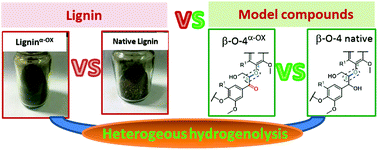Is oxidation–reduction a real robust strategy for lignin conversion? A comparative study on lignin and model compounds†
Abstract
This study focuses on the oxidation–reduction method for lignin depolymerization, an increasingly popular approach to lignin valorization. The effects of oxidative pretreatment on downstream lignin hydrogenolysis were carefully studied over various heterogeneous catalysts. It was found that oxidative pretreatment provided a promising strategy to produce renewable carbonyl-containing aromatics. However, oxidative pretreatment led to decreased monomer and aromatic oil yields compared to untreated lignin using W2C/AC and four commercial catalysts. The results with lignin contrasted with those of model compounds where the oxidative pretreatment led to increased efficiency in the cleavage of β-O-4 linkages. FT-IR, GPC, 2D HSQC NMR, GC-MS and elemental analysis characterization of lignin and ligninα-OX have been used to identify possible reasons for the contrasting results found with lignin and the model compounds. It is proposed that undesired degradation of linkages, condensation and modification of lignin occurred during lignin oxidation. This work provides an advanced perspective on the oxidation–reduction strategy for lignin depolymerization.

- This article is part of the themed collections: 2019 Green Chemistry Hot Articles and 2018 Green Chemistry Hot Articles


 Please wait while we load your content...
Please wait while we load your content...